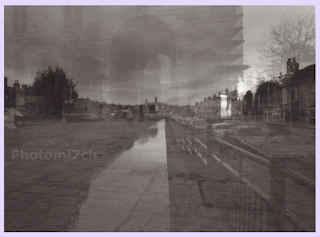 |
| Zero 6x9 pinhole camera. |
 |
| Zero 6x9 pinhole camera. |
The contact
print shows that the second exposures are quite weak and will require dodging
and burning to make their presence felt. With this in mind I have been using half page test strips so I can see how much more exposure is needed
to bring out the weaker parts of the negative. This has given me a better
overall idea of how much extra time the weaker parts of the picture need so I
can get as close as possible to what the final print will look like. Having chosen to use 6x6 negatives I find myself
cropping them to a landscape frame size giving me more choice over which parts
of the negative make the final composition and partly to get the best use out
of the paper size. I'm using Silverprint's gloss proof paper mainly because I
believe it has added something to the overall expression of the photographs.
 |
| Zero 6 x 9 pinhole camera. |
The results
of this first film have been a pleasant surprise in that most of the negatives
have produced picture combinations that work well. Whether this is down to luck
or the pre-planning in the picture combinations only time will tell. The day I
took the pictures was a challenge in that it was windy with a broken cloud sky
that was fast moving making metering each shot difficult. By the time I had
worked out the shutter speed and opened it the scene in some cases had gone
from bright sunshine to dull and overcast or vice versa. It just goes to show
how forgiving film is when it comes to exposing it in rapidly changing light
conditions over extended periods. These were printed at grade 3 and not my more common split procedure.
Technical data:
Film 120 FP4+ set to 6 x 6 negative size, developed in PMK Pyro, Printed on silverproof paper, developed in Ilford warmtone developer.







